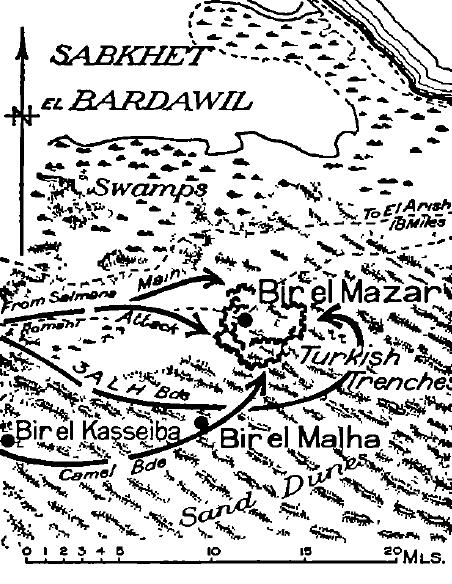Topic: BatzS - El Mazar
Bir el Mazar
Sinai, 17 September 1916
Gullett Account

Map detailing the attack on Bir el Mazar
[Extracted from Gullett, HS, The Australian Imperial Force in Sinai and Palestine, 1914–1918, p. 198.]
Gullett, HS, The Australian Imperial Force in Sinai and Palestine, 1914–1918 (10th edition, 1941) Official Histories – First World War
Volume VII
Chapter XIII
The Advance to El Arish
Early in September it was decided to make an attempt against the Turkish garrison at Mazar, some forty-four miles east of Romani, on the main northern track towards El Arish The Turkish force was believed to be 2,200 strong, made up of remnants of the troops which had fought at Romani, and supported by four mountain guns, a few anti-aircraft guns, and ten machine-guns. As there was no water-supply for the horses east of Salmana, 700 camels were organised to carry about twenty gallons each to a point ten miles east of Salmana, to meet Chauvel's troops as they returned, and provide a drink for the animals of two brigades. The 2nd and 3rd Light Horse Brigades, with the 1st Brigade as covering troops, were the main attacking body, supported by two batteries of Royal Horse Artillery. A few Australian companies of the Imperial Camel Corps, commanded by Captain G. F. Langley,* and supported by two guns of the Hong Kong and Singapore Mountain Battery, were ordered to proceed across the sands to the south, destroy a Turkish post believed to be at Kasseiba, and then join up with the main body before Mazar at daylight on September 17th.
The engagement at Mazar was always afterwards referred to in terms of strong disapproval by the regimental officers who participated. Soundly entrenched, the Turks occupied a bare sand-ridge with a good command over the approach from all sides, although most of their trenches faced west. On the night of the 15th Chauvel led his three brigades as far as Salmana, and remained there under the palm hods during the day of the 16th. The cover, however, was but slight; in the afternoon the Australians were discovered and machine-gunned by a German airman, and a few casualties were suffered. The pilot doubtless informed the garrison at Mazar of the British advance, and Chauvel was thus robbed of the chance of a surprise assault. Soon after dark the 2nd Brigade, which was now again under Ryrie's leadership, and the 3rd Brigade, under Royston, moved out and marched for Mazar, while the 1st Brigade followed for about ten miles and then remained in support. Ryrie appeared on the west of the enemy's position at dawn, and the 5th and 7th Light Horse Regiments, dismounting from their horses, advanced to within 700 or 800 yards of the trenches. A few small outposts were rushed and carried, but the advancing line then encountered sharp fire from mountain batteries and rifles at an effective range. At the same time the 3rd Light Horse Brigade had come up on the south, where Royston was looking out keenly for Langley's battalion of Camels. Langley, however, was late. He had found his route extremely sandy and slow, and in places the gullies between the dunes were so narrow that his men had to pass in single file. The 3rd Light Horse Brigade closed on the position on a very light front extending over two miles, with the right flank round as far as the telegraph wire on the east, which was cut. The whole line met with stout resistance; but the squadrons to the east were looking into the trenches from the rear, and all ranks of the 3rd Brigade, like those of the 2nd, were confident as to their capacity to carry the position with - out heavy losses.
Chauvel had explicit orders that, if the garrison was not taken by surprise and Overrun in the first rush, he was to consider the operation a reconnaissance in force and withdraw. On no account was he seriously to involve his brigades. Royston, on the south and south east, took an unfavourable view of the prospect; after the regiments had been held up for nearly three hours Chauvel decided at 7 o'clock to break off the engagement. Chauvel was doubtless influenced by the absence of the camel detachment, and also by the fact that, owing to a miscalculation by the native guide (a sergeant in the Sinai police), his two batteries had not up to this time come into action. A further consideration, and one which always weighed with Chauvel, was the wretched prospect ahead of his wounded if the engagement should prove expensive. Langley arrived between 7 and 8 o'clock, after the brigades had withdrawn, and the division then marched back to the water dCp8t. Chauvel was satisfied that, in the circumstances, he had correctly interpreted his unsatisfactory orders, and Murray fully endorsed his decision; but throughout the regiments there was bitter disappointment. The casualties of the division, most of which were suffered by the 7th Light Horse Regiment, were one officer and two other ranks killed, and nineteen other ranks wounded, while one Turkish officer and seventeen other ranks and a few Bedouins were captured.
Lieutenant F. W. Slatter of the 3rd Brigade Machine-Gun Squadron, was killed as he brought a machine-gun into action. The ambitious scheme for watering two brigades in the desert-which in its magnitude was probably without parallel - was frustrated by the absence of proper arrangements at the depot. Sound organisation had deposited 14,000 gallons of water at the appointed place, but adequate steps were not taken to make it available for the horses. As the regiments arrived, there was a wild, disorderly scramble about the troughs. The water was exhausted before a large portion of the two brigades had come up, and many horses went thirty hours without a drink. The protracted desert work was now telling heavily on the horses, particularly on those of the 1st and 2nd Brigades, which had been so long upon the desert. They were much reduced in condition, and had taken to eating the sand and camp refuse. The horsefeed coming forward from Egypt and other sources was of wretched quality, and it was plain that either negligence or corruption was responsible for the approval of it at the base. After Mazar the 1st and 2nd Brigades were ordered back to the Canal for a richly earned rest.
The enemy's estimate of the strength of his position at Mazar, and the degree to which he considered it menaced by Chauvel's troops on September 17th, were shown by his evacuation of the place two days later. Romani, however, continued to be for some time the advanced base of the British army; but substantial mobile forces were now encamped in advanced positions to the east of that stronghold, and were also extended over the oasis area to the south.
Additional Reading:
Bir el Mazar, Sinai, 17 September 1916
Battles where Australians fought, 1899-1919
Citation: Bir el Mazar, Sinai, 17 September 1916, Gullett Account



